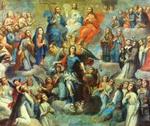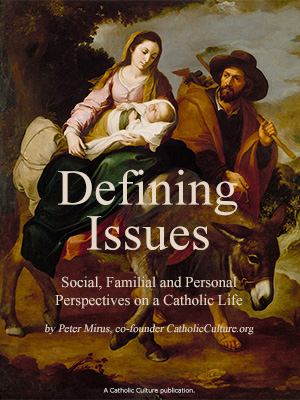Our Lady of Guadalupe
by Zsolt Aradi
The Conquistadores who found in the New World the shores of their golden dreams were men of courage and achievement, strong in their religious convictions. They attributed their success to the Power they believed in and considered themselves the messengers of a religion and a way of life that was superior.
In 1521, after many vicissitudes and deeds of bravery, Hernando Cortez and his followers succeeded in planting the Spanish Hag in the capital of the great Aztec Empire of Mexico. They had assumed the entire costs of their expedition and received from the Spanish crown in exchange the investiture of the country they would discover, on the sole condition of carrying the Gospel to its inhabitants. The religion practiced by the Aztecs was of a higher order than the barbaric animism the Spanish had expected to encounter, and in many respects it was marked by a strong morality, but this religion unfortunately included the practice of human sacrifice on an incredibly large scale.
The missionaries who followed the conquerors did much to improve the conditions of the Indians, and eventually made many converts among them.
The meaning of the miracle of Guadalupe is very simple. Our Lady appeared to the Aztec Indian Cuatitletoatzien, called by the Spaniards Juan Diego, in 1527. He lived in Cuautitlan and belonged to the mazohuales, the poorest and humblest of all among the Indians--his home a hut of dried mud with but one windowless room. Most of the Indians were suspicious of the Spaniards and did not welcome the Franciscan missionaries who came to them. But Juan Diego and his wife listened to their words, because they spoke of a Man who was nailed to the cross although He was the Only Son of their God. He too had been poor and humble. His birthplace a stable and his foster father a carpenter. This teaching greatly impressed Juan Diego and vaguely gave him comfort. When his wife died soon thereafter, he became a lonely man --an example and a symbol of his helpless people who felt themselves despised and without a protector.
At that time, Juan Diego gave no especial signs of zeal, although he went to religious instructions. One Saturday after Mass, on a bleak December day, he was walking about with heavy heart and sorrowful soul, cold and shivering. When Juan Diego reached the summit of the hill Tepeyac, the silence and sadness in his heart was almost unbearable. It was then a gentle voice called him by name . . .
The words of the Queen of Heaven to the poor Indian were very startling. She told him that he was to go to the Bishop of Mexico and tell him it was her desire that a temple be built on the spot where she now stood. "I am a merciful mother to thee and to all thy people on this earth who love me and trust me and invoke my help. I listen to their lamentations and solace them in all their sorrows and sufferings."
The Indian was asked to do the near impossible: to perform the first historical step. The inferior was asked to convey the message from the heavenly apparition to those in inaccessible position of authority. The dreaded Cortez was still alive and in Mexico. The first Bishop of Mexico, Zumarraga, lived in a palace surrounded by his court. True, Juan Diego was a Christian but the new God and all that surrounded him somehow seemed to him to belong to the rulers. He went reluctantly to the episcopal palace with its high walls and stately apartments. The servants lounging about the entrance eyed him with suspicion and took no trouble to hide their contempt. But he managed in some way to gain admittance to the audience chamber and to state his errand.
The bishop listened to him with courteous incredulity but not without kindness and told him to come back again when he had some proof of what he was saying. So Juan Diego returned to the barren rocky summit of Tepeyac. He did not doubt that he would find the Queen of Heaven waiting for him; this certainty and expectation is common to all those chosen to be witnesses of the apparition of Our Lady. She stood there again in her radiant robes and the poor Indian told her sorrowfully that the rulers thought his whole story was invented. But the apparition answered: "I implore and command thee to go again tomorrow to the bishop, give orders in my name, and let him know my will."
This second time Juan found it even more difficult to find access to Bishop Zumarraga, who was less favorable to him than he had been before. He coldly told Juan that he should return again and "bring with him some sign from the Queen of Heaven that he was speaking the truth." At this turn of events Juan Diego followed the promptings of his human nature and tried to find an excuse not to go to Tepeyac. He did not want to meet the Lady for he did not understand his role in the matter, and it seemed to him he had a good excuse. His uncle Juan Bernardino lay almost dying in a nearby village. He decided to visit the old man, and before reaching the summit of Tepeyac he turned and took the road to the village. But to his great astonishment the radiant Lady met him on the side of the hill. "What road is this you take, my son?" All the fears, griefs and shame of a beaten people were in his reply. Reassuring him about his uncle--whom at that instant she cured--she ordered Juan gently to climb again to the summit. Obeying her, he found to his astonishment on this bleak and cold December day the most beautiful roses blooming in abundance; they were fragrant and covered with dewdrops. He picked the roses, placed them in his tilma and ran back to the Lady who rearranged them and told him to keep them hidden until he could show them to the bishop. Juan Diego started out joyfully for the bishop's palace, for now he knew he had the sign he had been asked to bring.
On his third visit he was humiliated even further by the courtiers before reaching the bishop's chambers, but coming before Zumarraga he told what he had seen on the rocks: "beautiful roses, washed with dew . . . these I gathered and carried back to her; with her own hands she arranged them and placed them in my robe so that I might bring them to you. Here they are. Behold and receive them."
Then he unfolded his tilma and let the roses fall gently to the floor. And as he stood there in near ecstasy, his eyes cast upon the roses, he did not see Bishop Zumarraga descend from his throne and fall upon his knees. The bishop was not looking at the flowers but at the drab and roughly woven Indian garb on which was painted the image of the Virgin, her hands clasped in prayer as she appeared to Juan Diego on the barren summit of Tepeyac. And Our Lady bore the features of an Indian woman; her garb was Indian . . .
The miracle of Guadalupe marked the reconciliation of the Christian world, which was Spanish with the American and Indian world, rooted deep in the soil of the new hemisphere, and it was a gentle admonition to both. Through it the conqueror was taught humility, the native lifted up to an equality that can be achieved through the Christian faith.
Today the shrine of Guadalupe is a place of pilgrimage, almost within the limits of the City of Mexico. But this is only the center of devotion to Our Lady of Guadalupe, all of Mexico is absorbed by her and she has been absorbed by Mexico. Through her reconciliation of two extremes, a nation was born, and she is the symbol of the process of amalgamation that has created the nations of North and South America. It is for this reason that Pope Pius XI declared her the Patroness of all the Americas, from Alaska through Canada and the United States to the southernmost tip of Tierra del Fuego.
Following Our Lady's appearance to Juan Diego, the interests of the Spaniards and the Mexican Indians continued to diverge and to clash, for Divine Providence does not alter the course of every human event due to man's free will. But in times of peace or revolution she remained the rallying point and the greatest force for final reunion. She was named Our Lady of Guadalupe in memory of the Guadalupe in Spain. Over the years her chapel grew into a church, and the church into a basilica. She was crowned three times by papal decree. She became the focal point around which the Indian racial consciousness developed into a true national feeling and created Mexico. Her image was carried on Hidalgo's banner. During the persecution of the 1920's, the executed died with her name on their lips, and her shrine was never closed, even during the most bitter fighting between Church and State in Mexico. She, the Mystical Rose, became the Ark of the Covenant to create peace and concord in the melting pot of peoples and races. Her title, Patroness of All the Americas, clearly expresses her function.
This item 3178 digitally provided courtesy of CatholicCulture.org






